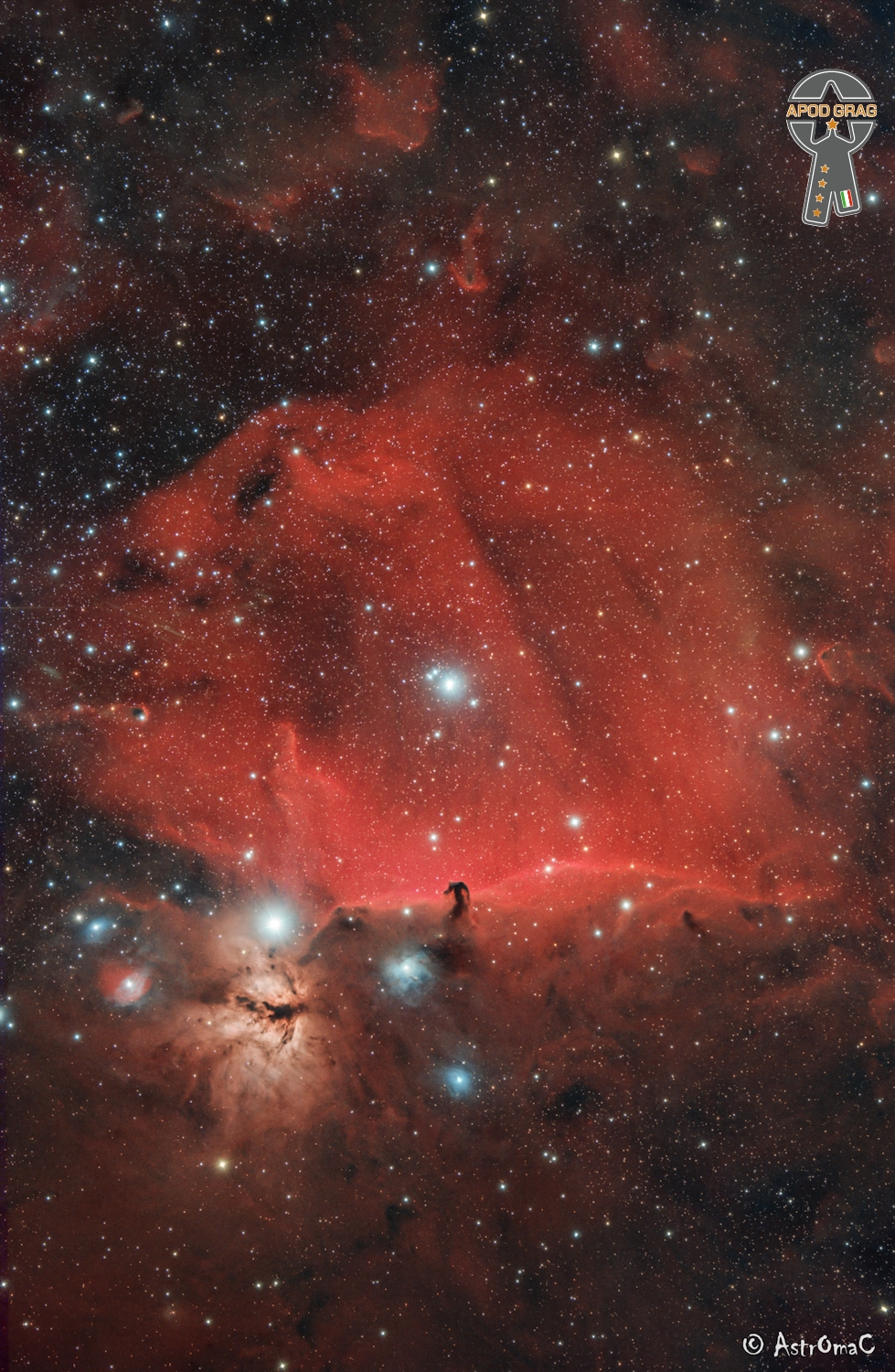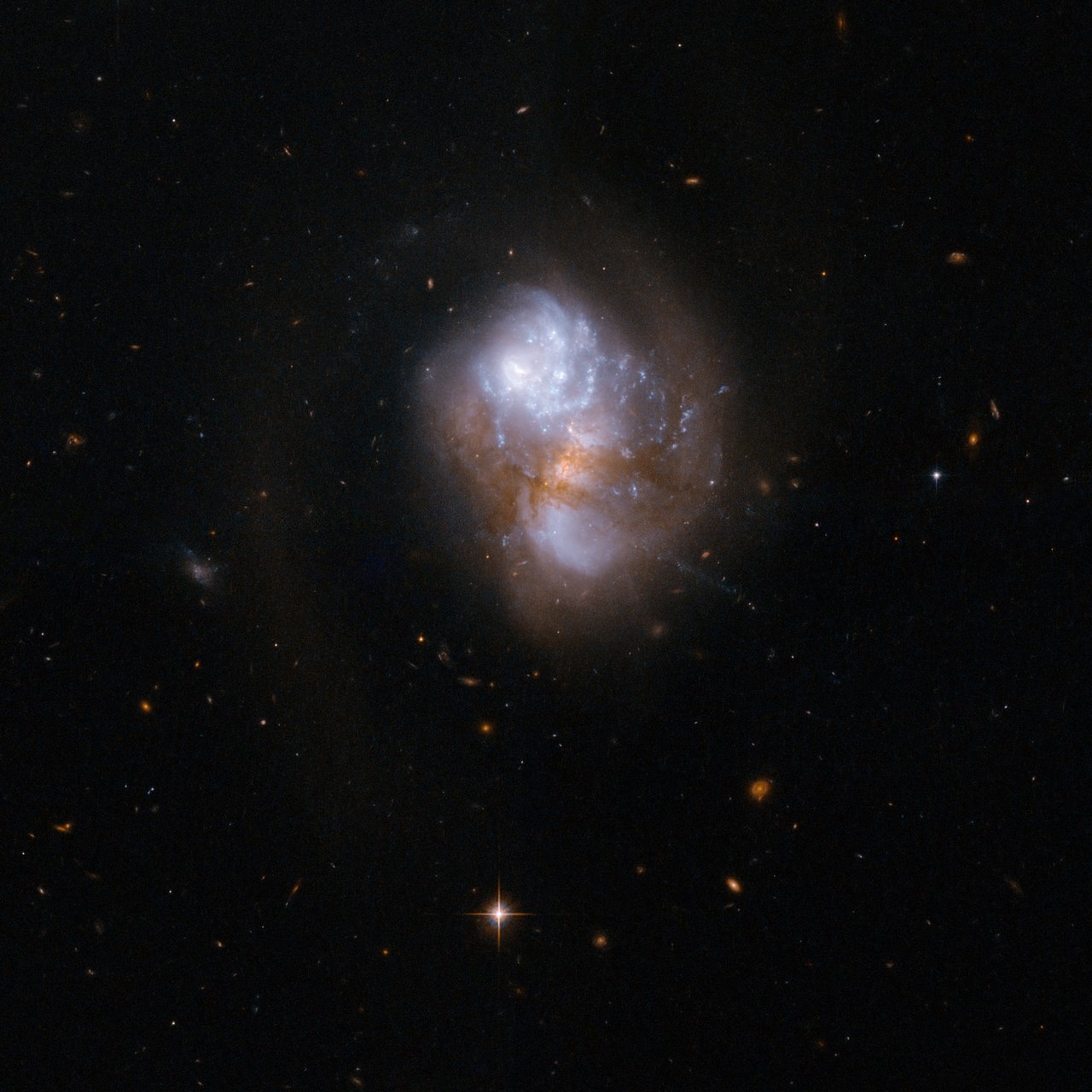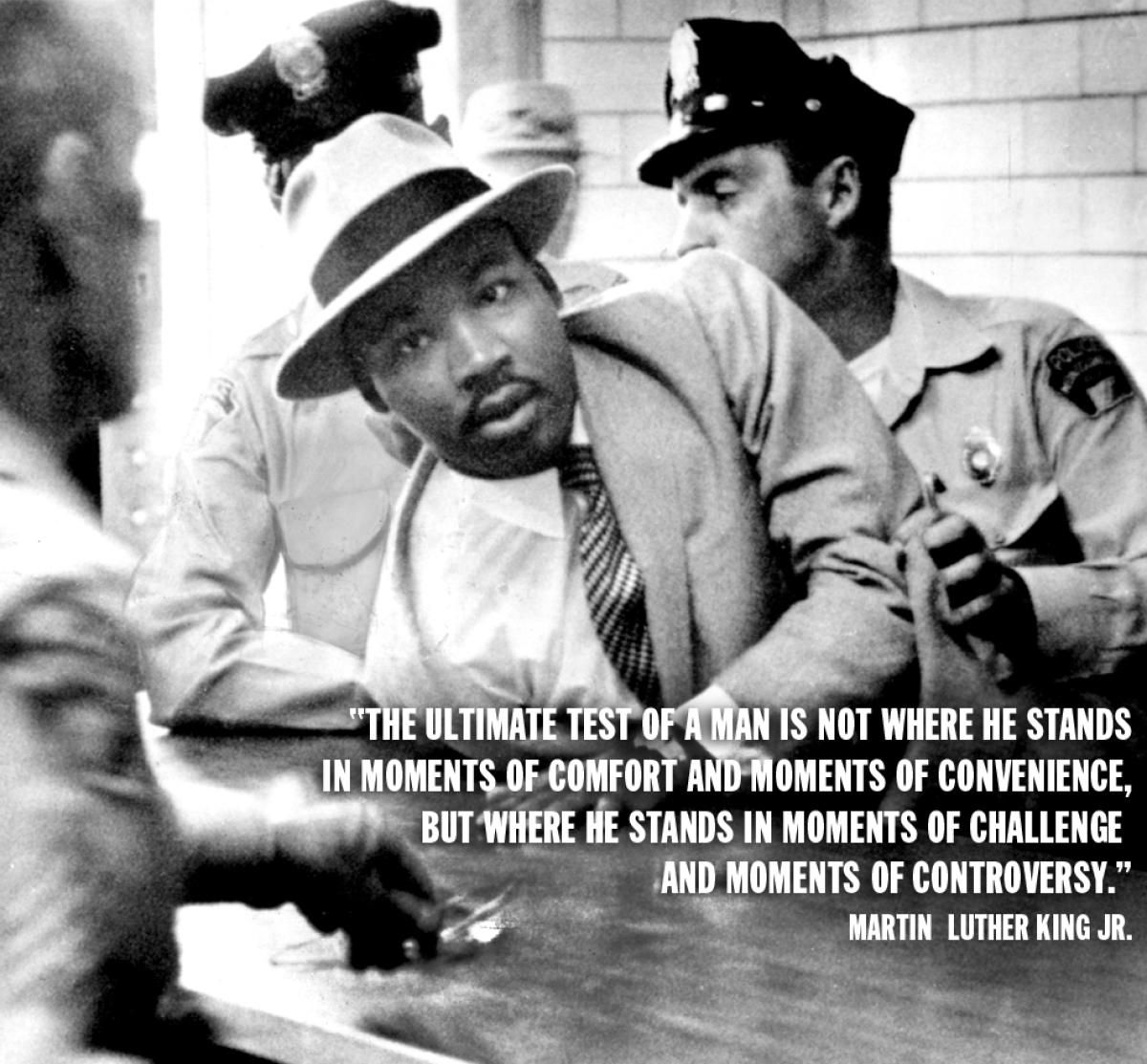Blog
IC 434 is a bright emission nebula in the constellation Orion. It was discovered on February 1, 1786 by William Herschel. The Horsehead Nebula is a dark nebula silhouetted against it 1,500 ly away.

more...
Steven Mark Grossman (January 18, 1951 – August 13, 2020) was an American jazz fusion and hard bop saxophonist.
Grossman was Wayne Shorter‘s replacement in Miles Davis‘s jazz-fusion band. Then, from 1971 to 1973, he was in Elvin Jones‘s band. In the late 1970s, he was part of the Stone Alliance trio with Don Alias and Gene Perla. The group released four albums during this period, including one featuring Brazilian trumpeter Márcio Montarroyos. The albums also feature an array of other musicians. They went on to release three live reunion albums during the 2000s.
Grossman was born in Brooklyn, New York, United States, on January 18, 1951, to Rosalind, an amateur pianist, and Irving, an RCA salesman and later president of KLH Research and Development Corporation. He died of cardiac arrest in Glen Cove, New York, on August 13, 2020, at the age of 69.
more...David Eli Ruffin (born Davis Eli Ruffin, January 18, 1941 – June 1, 1991) was an American soul singer and musician most famous for his work as one of the lead singers of the Temptations (1964–68) during the group’s “Classic Five” period as it was later known. He was the lead voice on such famous songs as “My Girl” and “Ain’t Too Proud to Beg.”
Known for his unique raspy and anguished tenor vocals, Ruffin was ranked as one of the 100 Greatest Singers of All Time by Rolling Stone magazine in 2008. He was inducted into the Rock and Roll Hall of Fame in 1989 for his work with the Temptations. Fellow Motown recording artist Marvin Gaye once said admiringly of Ruffin that, “I heard [in his voice] a strength my own voice lacked.”
Ruffin was born Davis Eli Ruffin on January 18, 1941, in the rural unincorporated community of Whynot, Mississippi, 15 miles from Meridian, Mississippi. He was the third born son of Elias “Eli” Ruffin, a Baptist minister, and Ophelia Ruffin. His siblings were Quincy B. Ruffin, Reada Mae Ruffin, and Jimmy Lee Ruffin. Ruffin also had another sister Rosine, who died in infancy.
After completing a successful month-long tour of England with Kendricks and Edwards, David Ruffin died on June 1, 1991, from an accidental overdose of crack cocaine. Ruffin had reportedly collapsed at a West Philadelphia crack house, where he had gone with his friend Donald Brown, according to authorities.
more...Aloysius Tyrone Foster (born January 18, 1943) is an American jazz drummer. Foster played with Miles Davis during the 1970s and was one of the few people to have contact with Davis during his retirement from 1975–1981. Foster also played on Davis’s 1981 comeback album The Man with the Horn. He was the only musician to play in Davis’s band both before, and after, his retirement. He has toured extensively with Herbie Hancock, Sonny Rollins, and Joe Henderson.
Foster was born in Richmond, Virginia, United States, and grew up in New York. He began playing drums at the age of 13 and made his recording debut on Blue Mitchell‘s, The Thing to Do, at age 20.
He joined Miles Davis‘s group when Jack DeJohnette left in 1972, and played with Davis until 1985. In his 1989 autobiography, Davis described the first time he heard Foster play live in 1972 at the Cellar Club in Manhattan: “He [Foster] knocked me out because he had such a groove and he would just lay it right in there. That was the kind of thing I was looking for. Al could set it up for everybody else to play-off and just keep the groove going forever.”
Foster began composing in the 1970s, and has toured with his own band, including musicians such as bassist Doug Weiss, saxophonist Dayna Stephens, and pianist Adam Birnbaum.
https://www.youtube.com/watch?v=UqQcO9VybjI
more...Giannis Papaioannou (Greek: Γιάννης Παπαϊωάννου; January 18, 1913 – August 3, 1972) was a famous Greek musician and composer born in Kios, Ottoman Empire (now Gemlik, Turkey). In English his name is sometimes romanticized as Yannis, Ioannis or Yiannis. Most active in the 1940s, he wrote many songs, some of which are today considered classics of the rebetiko folk music style. These include: Pente Ellines Ston Adi, Kapetan Andreas Zeppo, Modistroula, Prin To Charama Monachos, and Fovamai Mi Se Chaso. His style retains much of the musical quality of the classical rebetika of the likes of Markos Vamvakaris, although the thematic content of the lyrics tends not to focus as much on the typically dark topics – drugs, death and prison – of earlier rebetika.
He died in Athens on August 3, 1972 in a road accident and was buried in a cemetery in Kallithea, just southwest of Athens near the Tzitzifies area of south Kallithea where he, like many other rebetiko and laiko musicians, would frequently perform.
more...https://www.youtube.com/watch?v=9kr-_uum-3I
more...The spiral arms of the galaxy NGC 3318 are lazily draped across this image from the NASA/ESA Hubble Space Telescope. This spiral galaxy lies in the constellation Vela and is roughly 115 light-years away from Earth. Vela was originally part of a far larger constellation, known as Argo Navis after the fabled ship Argo from Greek mythology, but this unwieldy constellation proved to be impractically large. Argo Navis was split into three separate parts called Carnina, Puppis, and Vela — each named after part of the Argo. As befits a galaxy in a nautically inspired constellation, the outer edges of NGC 3318 almost resemble a ship’s sails billowing in a gentle breeze. Despite its placid appearance, NGC 3318 has played host to a spectacularly violent astronomical phenomenon, a titanic supernova first detected by an amateur astronomer in 2000. Thanks to NGC 3318’s distance from Earth, the original supernova must have taken place in or around 1885. Coincidentally, this was the year in which the only supernova ever to be detected in our neighbouring galaxy Andromeda was witnessed by 19th-century astronomers.

Michael Kevin Taylor (born 17 January 1949) is an English musician, best known as a former member of John Mayall’s Bluesbreakers (1967–69) and the Rolling Stones (1969–74). As a member of the Stones, he appeared on: Let It Bleed (1969), Get Yer Ya-Ya’s Out! The Rolling Stones in Concert(1970), Sticky Fingers (1971), Exile on Main St. (1972), Goats Head Soup (1973) and It’s Only Rock ‘n Roll (1974).
Since leaving the Rolling Stones in December 1974, Taylor has worked with numerous other artists and released several solo albums. From November 2012 onwards he participated in the Stones’ 50th-Anniversary shows in London and Newark, and in the band’s 50 & Counting tour, which included North America, Glastonbury Festival and Hyde Park in 2013. He was ranked 37th in Rolling Stone magazine’s 2011 list of the 100 greatest guitarists of all time.[1] Guns N’ Roses guitarist Slash states that Taylor had the biggest influence on him.
https://www.youtube.com/watch?v=zMXt414Zr5o
more...Billy Harper (born January 17, 1943) is an American jazz saxophonist, “one of a generation of Coltrane-influenced tenor saxophonists” with a distinctively stern, hard-as-nails sound on his instrument. He was born in Houston, Texas, United States. In 1965, Harper earned a Bachelor of Music degree from the University of North Texas.
Harper has played with some of jazz’s greatest drummers; he served with Art Blakey‘s Messengers for two years (1968–1970); he played very briefly with Elvin Jones (1970), he played with the Thad Jones/ Mel Lewis Orchestra in the 1970s, and was a member of Max Roach‘s quartet from 1971–1978. In 1979, Harper formed his own group, touring with it and documenting its music on the recording Billy Harper Quintet in Europe, and he was featured as a soloist on a 1983 recording, Such Great Friends, with virtuoso, visionary pianist and record producer Stanley Cowell. After a period of relative inactivity in the 1980s, Harper came back strong with another international tour, which ended with perhaps his most ambitious recording: the three-volume Live on Tour in the Far East (1991). In the new millennium, Harper’s recording activity has been subdued and sporadic, though more recently he appeared as a regular member of pianist-jazz historian Randy Weston‘s ensembles. In 2013, they recorded their first album as a duo, entitled The Roots of the Blues.
https://www.youtube.com/watch?v=_2rkN-MS7fA
more...Cedar Anthony Walton, Jr. (January 17, 1934 – August 19, 2013) was an American hard bop jazz pianist. He came to prominence as a member of drummer Art Blakey‘s band, The Jazz Messengers, before establishing a long career as a bandleader and composer. Several of his compositions have become jazz standards, including “Mosaic”, “Bolivia”, “Holy Land”, “Mode for Joe” and “Ugetsu/Fantasy in D”.
Walton was born and grew up in Dallas, Texas. His mother Ruth, an aspiring concert pianist, was his first teacher, and took him to jazz performances around Dallas. Walton cited Nat King Cole, Bud Powell, Thelonious Monk and Art Tatum as his major influences on piano. He began emulating these artists’ recordings from an early age.
After briefly attending Dillard University in New Orleans, he entered the University of Denver as a composition major, but was encouraged to switch to a music-education program with the goal of a career in the local public school system. This later proved extremely useful, as he learned to play and arrange for various instruments, a talent he honed with Art Blakey’s Jazz Messengers.
more...Sidney “Big Sid” Catlett (January 17, 1910 – March 25, 1951) was an American jazz drummer. Catlett was one of the most versatile drummers of his era, adapting with the changing music scene as bebop emerged.
Catlett was born in Evansville, Indiana, United States, and at an early age he was instructed in the rudiments of piano and drums, under the tutelage of a music teacher hired by his mother. When he and his family relocated to Chicago, Catlett received his first drum kit, and immersed himself in the diverse styles and techniques of Zutty Singleton, Warren “Baby” Dodds, and Jimmy Bertrand, among others.
In 1928, Catlett began playing with violinist and clarinet player Darnell Howard, before joining pianist Sammy Stewart’s Orchestra in New York City, and making appearances at the Savoy Ballroom.
more...IC 1623 is an interacting galaxy system that is very bright when observed in the infrared. One of the two galaxies, the infrared-bright, but optically obscured galaxy VV 114E, has a substantial amount of warm and dense gas. Warm and dense gas is also found in the overlap region connecting the two nuclei. Observations further support the notion that IC 1623 is approaching the final stage of its merger, when a violent central inflow of gas will trigger intense starburst activity that could boost the infrared luminosity above the ultraluminous threshold. The system will likely evolve into a compact starburst system similar to Arp 220. IC 1623 is located about 300 million light-years away from Earth. This image is part of a large collection of 59 images of merging galaxies taken by the Hubble Space Telescope and released on the occasion of its 18th anniversary on 24th April 2008.

Helen Folasade Adu CBE (Yoruba: Fọláṣadé Adú [fɔ̄láʃādé ādú]; born 16 January 1959), known professionally as Sade Adu or simply Sade (/ʃɑːˈdeɪ/shah-DAY), is a Nigerian-born British singer, songwriter, and actress, known as the lead singer of her eponymous band. One of the most successful British female artists in history, she is often recognised as an influence on contemporary music. Her influence on music was recognised in the UK with an award of the Officer of the Order of the British Empire in 2002, and was made Commander in the 2017 Birthday Honours.
Sade was born in Ibadan, Nigeria, and brought up partly in Essex, England, from the age of four. She studied at Saint Martin’s School of Art in London and gained modest recognition as a fashion designer and part-time model, prior to joining the band Pride in the early 1980s. After gaining attention as a performer, she formed the band Sade, and secured a recording contract with Epic Records in 1983. A year later the band released the album Diamond Life, which became one of the best-selling albums of the era, and the best-selling debut by a British female vocalist. In July 1985, Sade was among the performers at the Live Aid charity concert at Wembley Stadium, and the following year she appeared in the film Absolute Beginners. Following the band’s third and fourth albums, Stronger Than Pride (1988) and Love Deluxe (1992), they went on hiatus after the birth of Sade’s child, while the singer experienced widespread media coverage for unsubstantiated claims of mental health and addiction problems.
After a spell of eight years without an album, the band reunited in 1999, and released Lovers Rock in 2000. The album departed from the jazz-inspired inflections of their previous work, featuring mellower sounds and pop compositions. The band then underwent another hiatus, not producing music for another ten years until the release of Soldier of Love. Following that album’s release, the band entered a third period of extended hiatus, and have only released two songs (“Flower of the Universe” for the soundtrack of Disney‘s A Wrinkle in Time, and “The Big Unknown” as part of the soundtrack for Steve McQueen‘s film Widows) since.
more...
Aldo Romano (born 16 January 1941) is an Italian jazz drummer. He also founded a rock group in 1971.
He was born in Belluno, Italy. Romano moved to France as a child and by the 1950s he was playing guitar and drums professionally in Paris, but he first gained attention when he started working with Don Cherry in 1963. He recorded with Steve Lacy, and would go on to tour with Dexter Gordonamong others. In the 1970s, he moved into rock-influenced forms of jazz fusion and, in 1978, made his first album as a leader. In the 1980s, he returned to his earlier style for several albums. Although he has lived most of his life in France, he has retained an affection for Italy and has set up a quartet of Italian jazz musicians. Romano also played a role in starting the career of French-born Italian-French pianist, Michel Petrucciani. In 2004 he won the Jazzpar Prize.
more...More Posts
- Diana Ross
- Rufus Thomas
- Donald Bailey
- James Moody
- World Drumming Olatunji
- Daily Roots King Tubby Techniques All Stars
- Dept of Education Survival
- Echos of Freedom Booker T Washington
- Master Race Illusion
- Cosmo NGC 2403
- Elton John
- Béla Bartók
- Aretha Franklin
- Paul Motian
- Cecil Taylor
- World Music Kyenkyen Bi Adi M’awu
- Daily Roots Rupie Edwards
- Echos of Freedom H.P. Lovecraft
- Cosmo NGC 5530
- Lee Oskar
